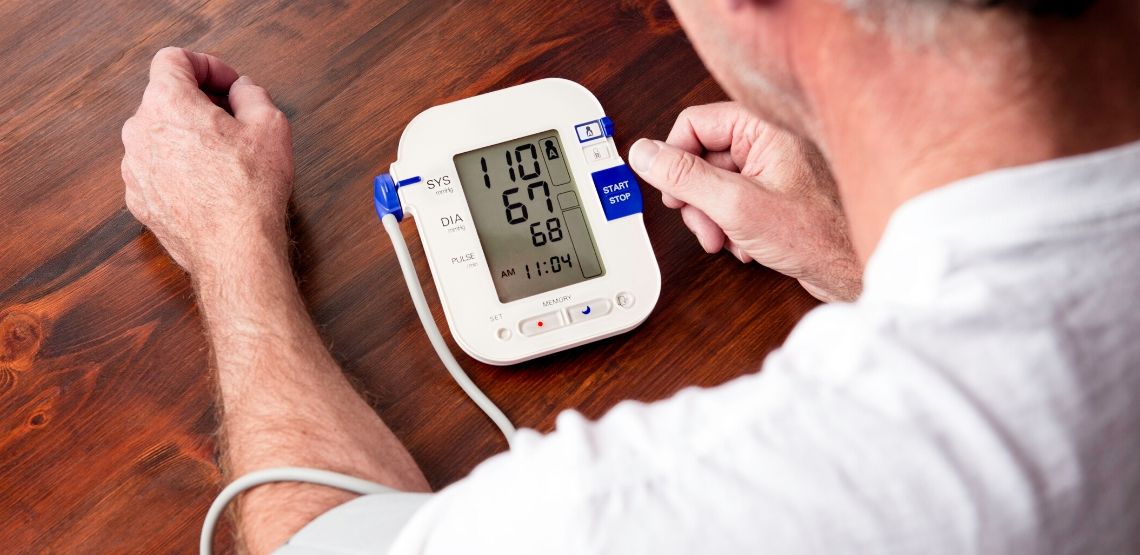How do You Lower Blood Pressure?
High blood pressure can be a “silent killer" because there are so few signs that you have high blood pressure. However, if you are at risk, there are steps you can take to lower it.
We hear a lot about how it is important to keep a healthy pressure, but what exactly does blood pressure mean?
What is Blood Pressure?
It is a measurement of how much (or little) your blood is pressing on your blood vessels as it is pumped through your body. For example, the higher the pressure, the more forcefully the blood moves through the body and the more forcefully it presses against the insides of the various blood vessels.
A blood pressure reading after a test consists of two numbers which are shown on top of one another, much like how a fraction is written. The top number is called the systolic blood pressure and is the highest level of pressure your blood reaches when your heart beats. The bottom number is the diastolic blood pressure, which the lowest level your pressure reaches between your heartbeats.
Preparing for a Test
A blood pressure test is not invasive at all and only takes a few minutes. You also do not have to prepare before you have the test. Just make sure to wear a t-shirt or short sleeved shirt or have sleeves that can easily roll up. This will make it easier for the nurse or technician to affix the inflatable cuff around your arm and get an accurate reading.
How is Your Blood Pressure Tested?
To do the test, you will be seated in a chair in an examination room. Your arm will be supported and resting at heart level. Both your feet will be flat on the floor and your back will be supported by a chair.
The nurse or technician who does the test will wrap an inflatable cuff around your arm, just above your elbow. (This cuff is attached to a dial or digital display.)This is called a sphygmomanometer. You will notice that the nurse uses a cuff that is suitable for your arm - a smaller or larger one, and a children’s or adult one — so do not worry about it not fitting. Now the test can be performed and you should not talk and try not to move your arm.
What to Expect
The nurse will first feel for your pulse at your wrist before taking a reading with the sphygmomanometer. The cuff is inflated (this may pinch for a few seconds as the cuff tightens, but try to remain relaxed. It will deflate once the measurements are recorded.
Some of the tests are done entirely automatically — including taking your pulse. In this case, the cuff will inflate and deflate, and the reading along with your pulse rate will appear on the screen. It is this reading that the doctor or nurse will use. The reading is a measurement in millimeters of mercury or mmHg.
The test may be performed on one or both arms and may be performed twice on one arm to ensure that the reading is as accurate as possible. A single blood pressure measurement takes about a minute.
Why is Healthy Blood Pressure Important?
It is not only a sign of good health, it also puts less stress and pressure on your:
- Heart
- Blood vessels
- Kidneys
- Eyes
- Brain
- Other internal organs.
This pressure can have a negative affect in the long run and lead to other conditions.
Why is High Blood Pressure Dangerous?
In short, it can lead to heart attacks and even strokes. The reason why it is so dangerous is that high blood pressure does not have any obvious physical symptoms. However, the higher your pressure, the greater the amount of pressure that is placed on your blood vessels.
It is very important to keep your pressure at a healthy level and if your blood pressure is high, make sure to try and lower it. This can be done with a combination of medication and lifestyle changes, depending on how high your blood pressure is.
How can You Lower Your Blood Pressure?
Lowering your blood pressure is possible with certain lifestyle changes.
Losing Weight
This is important, especially in your abdomen and around your waist. Extra weight around your waist may put you at a higher risk of high blood pressure. In general, men are at risk if their waist measures more than 40 inches or 102cm and women are at risk if their waist measures more than 35 inches or 89cm. (As measurements differ between ethnic groups, you should consult your doctor on a healthy waist measurement.)
Regular Exercise
This is a must for lifestyle change. Try to get 30 minutes of exercise every day. If you are very unfit, work up to 30 minutes of exercise. You can also try some different types of exercises to see what suits you the best. If you have any other health conditions or injuries, make sure to first see a health care practitioner, physiotherapist or similar health care worker for advice.
Eating Healthy
This is also very important. Eating healthy will help lower your chance of developing certain health conditions. You can start by keeping a food diary for a week or two to get a true sense of your eating habits. This will give you a good indication of what habits you need to change. Your diet should be rich in whole grains, fruits, vegetables and low-fat dairy products. Only a little saturated fat and cholesterol. Limiting the amount of alcohol you drink should also be included in your healthy diet.
Stop Smoking
If you are a smoker, this can also lead to higher pressure, not to mention a multitude of other health issues.
Manage Stress
Stress can be lessened through meditation or prayer, yoga or tai chi, massage and deep breathing exercises. If you feel it is needed, see a counselor or psychologist. They can help you put in place healthy ways of coping with and lessening stress in your life.
When to See a Doctor
Symptoms which need immediate medical attention when you are being treated for are:
- Headaches
- Shortness of breath
- Nosebleeds
- Flushing
- Dizziness
- Chest Pain
- Palpitations or irregular heartbeat
- Visual changes
- Blood in your urine
- Excessive sweating
These symptoms are extremely serious and should not be ignored. You should also see your doctor if you are not responding to the treatment regime that has been prescribed for you by your doctor.
It is important to have your blood pressure tested on a regular basis — at least once per year and more often if your blood pressure is elevated or high.


